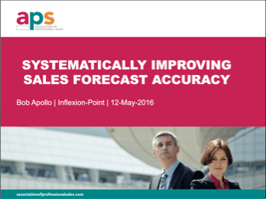Here are my key recommendations:
STEP 1: CLEARLY DEFINED SALES PROCESS
It’s impossible to have confidence in the numbers in our forecast without a clearly defined, highly effective and widely adopted sales process. As W Edwards Deming (father of the quality revolution) so aptly put it, “If we can’t describe what we are doing as a process, we don’t know what we’re doing”.
Effective sales processes must:
- Include a series of clearly-defined stages that reflect the buying decision journey
- Require progress to be based on the prospect achieving verifiable milestones
- Offer clear guidance as to what sales people need to know and do at each stage
You can learn more in the webinar.
STEP 2: UNAMBIGUOUS FORECASTING GUIDELINES
Establishing unambiguous forecasting guidelines is every bit as important as having a clearly defined sales process. We need to implement clearly defined categories, such as COMMIT, PROBABLE and UPSIDE and be clear about how each category must be implemented in practice.
We need to apply a similar rigour to “close dates”. One of the most common causes of forecast inaccuracy is to apply a close date that the sales person aspires to but the prospect has no obvious reason to comply with. Repeated close date slippage is a classic indicator.
Finally, we need to make sales people accountable for the accuracy of their forecasts – and that means measuring their actual performance against forecast. This is not an opportunity for punishment – it’s an opportunity for coaching.
You can learn more in the webinar.
STEP 3: GUIDED SELLING
It’s all very well having a defined sales process – but we need to take steps to ensure that it is adopted. That requires that our sales people believe that it is in their interest to follow it, and that they further believe that they will be more successful if they do.
Incorporating the winning habits of your top sales performers into the process is a critical element of getting buy-in – and it’s hard to imagine how you can define a truly effective sales process without their inputs.
Implementing a handful of critical checklist items per stage, highlighting relevant materials and applying simple visual RED–AMBER–GREEN status flags can have a transformative impact on process adoption. You can learn more in the webinar.
STEP 4: ANALYSE THE PAST, VISUALISE THE PRESENT AND PREDICT THE FUTURE
We can no longer afford to rely on spreadsheets and tabular reports to help us see what’s really been going on in our pipelines or to make any sort of informed judgement about the short or long term future. Of course, selling depends on creativity but it also depends increasingly on data.
That may be why investing in sales analytics is the top technology priority for many sales leaders in 2016. Unlike traditional BI solutions, specialist sales analytics applications from organisations like InsightSquared answer key sales management questions without the need for IT involvement.
Perhaps most powerful of all, the dashboards and reports of these specialised solutions are being continuously enhanced to reflect the accumulated learning from hundreds and thousands of sales organisation. They can not only answer the questions you have already thought of, but also come up with insights you may never have dreamed of.
You can learn more in the webinar.
IN CONCLUSION
Successful selling is not just a combination of art and science – creativity and data – it is also increasingly about engineering: recognising patterns of success and failure and systematically applying proven process to amplify the former and eliminate the latter.
I hope you are able to take the time to review the contents of the webinar, and to add your comments below – please contribute your experiences.

 As we’re all very well aware, complex sales are complicated. There are subject to a wide range of factors that are outside of our direct control. It’s no wonder that forecasting if and when any individual deal is likely to come in is such a challenge.
As we’re all very well aware, complex sales are complicated. There are subject to a wide range of factors that are outside of our direct control. It’s no wonder that forecasting if and when any individual deal is likely to come in is such a challenge.

